|
 Daily things in Japan Daily things in Japan
|
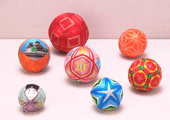 |
<Higo-temari>
Below is the minimal guide just to get by in Japan for a few days.
Photo of Higo-temari©Kumamato Prefectural Traditional Crafts Center
Followings may be useful for you.
 Cultural differences Cultural differences
Although Japan appears to be very much Westernized, you will find quite different customs here and
there, which one should expect to encounter. Just like you being in any other foreign country, do not
assume anything to be the same to what you have been accustomed to.
 Greetings Greetings
When you meet a person, bowing is the most common. The more you bend your body forward from the
waist, the more polite it is. In fact, many companies and stores train their employees to bend to a
particular angle depending upon the situation. There even exist machines to measure the bending angle
for the training.
Shaking hands is not the standard, although you may observe this to happen often
enough to consider that this is an acceptable standard way. So, shaking hands is OK.
Hugging and kissing in public is not considered to be appropriate even between close
friends. (Some of the daring young-generation started to do this in public only
recently.) |
 |
 No shoes inside of a Japanese house. No shoes inside of a Japanese house.
There is a space where you leave your shoes right after you passed an entrance door. (This space is
called "genkan" meaning entrance). You may be offered a pair of slippers at the "genkan". However, you
must remove the slippers in a "tatami" room.A "tatami" is a straw matting which is the floor finish of a
standard Japanese room. You may also find another pair of slippers in toilet. Use the toilet slippers only
inside the toilet.
Do not forget to change back to your slippers (if offered) when you are coming out of the toilet.
 Taking a bath Taking a bath
Taking a bath is one of the standard way to relax in Japan reflecting the rather
humid (and hot during summer months) weather throughout the year. You
might be invited to a house and offered to take a bath before a dinner. This by
no means meant that the host had any doubt about your hygiene.
It is an extra courtesy offered to an honored visitor. You will find a rather deep
bathtub filled with hot water. Wash and rinse off yourself outside of the bathtub
before you step into the bathtub. Do not get soap in the bathwater.
|
 |
The bath water is to warm you up for relaxation. You should enter the tub clean. The bathwater will be
used
by others later. Do NOT drain the bathwater when you are getting out. Same rule applies when
you bathe in a public bath. |
 Napkins and tissue papers Napkins and tissue papers
Napkins for a dining is NOT a common thing in Japan since proper use of chopsticks will not cause a
splash of food on yourself neither around your mouth. However, by Murphy's law, this may happen.
Hence it is recommendable to always carry a pocket handkerchief with you. You will rarely find paper
towel in toilets so that you need a handkerchief after you wash your hands. Yes, you will find toilet
papers in toilet for MOST cases.However, you will NOT find toilet papers in toilets at most train stations,
but you may (often) find a vending machine for tissue papers. (No, it will not be a big roll of toilet
papers.)
 Drive a car on the LEFT-side Drive a car on the LEFT-side
It is well known that they drive on the LEFT-side of a road in Japan. This causes a potential problem
when you cross a road unless you are familiar with the same traffic system like in England. Watch for a
traffic very carefuly repeatedly before you make a crossing. It is your life in stake.
 Japanese-style toilets Japanese-style toilets
Japanese-style toilets are more common over Western-style toilets, 'yohshiki-toire' So you have to get
used to using Japanese-style ones. Chances to find western style toilets is low at train stations, at local
inns etc..
You will have a better chance to find them at restaurants, hotels, department stores in big cities.
Japanesestyle toilet offers nothing to sit on. So you must squat over the toilet. Some public toilets, may
have no toilet-papers. It is recommendable to always carry a pocketable tissue papers.
How to use Japanaesestyel toilets :http://www.japan-guide.com/e/e2003.html 
|
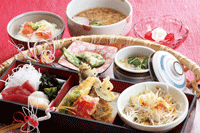 |
Japanese food reflects the history and environment like anything else. Major ingredients of Japanese dishes such as rice, 'tofu' (bean-curd), 'miso' (fermented soy bean) and 'sho:yu'(soy sauce) came from outside (mainly from China) well before 10th century. In Heian period (794-1185), development of a distinctive style of cuisine started. At the
same time, the influence of China was (especially of animals but less strict
on fishes) around that time. Kyoto being rather far from the ocean, various preservation
methods were also developed. |
It was only in the late 19th century that the influence of Americans and Europeans added more variety
to Japanese cuisine and Japanese restarted to eat animal meats again.
Fish (or seaweed) soup base ('dashi'), 'miso', 'shoyu' are still dominant seasonings, in addition to salt,
sugar, and rice wine('sake'). Japanese food style is in a way similar to a sandwich where, bread is
replaced by cooked rice and anything else is to add a variety to the taste of rice. Rice is the center piece
of Japanese cuisine and everything else, called 'okazu', are to enhance the taste of rice (or sometimes
the rice wine).
It is true that Japanese eat bread, pasta, caviar, pizza, or whatsoever nowadays. But, home cooking is
still
dominated by rice-based dishes. It is the taste of rice that profoundly charmed the Japanese, and
rightly so.
Noodles used to be called as substitute food and are offered when rice is not available for some reason.
Japanese food is relatively bland and simple. They do not meddle with the food material too much.
The Japanese dishes we would recommend are: ’tempura’ (deep fried
seafood and vegetables), ‘sushi’ (raw or cooked seafood on vinegar’ed rice),
‘sakana no shioyaki’ (roasted fish with salt), ‘kaiseki ryohri’ (a sophisticated
full course dinner), ‘Una-don’ (BBQ’ed eel on rice), (‘Unagi no shiroyaki’ is a
more delicate eel dish, if you can find it.)
Of course, there are only a few good restaurants (if any) and many so-so (or
poor quality) restaurants in most cities. |
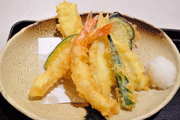 |
There is one more distinctive feature in Japanese food. Each dish will be served on a selected plate to
make it look most appealing, in addition to the effort to make it taste good. Hence common dinner set
type plates and bowls are not preferred.
The same idea is seen in various part of Japanese life; flower arrangement, tea ceremony (We would
translate it as "tea party"), a little garden, etc.When food became more than just an energy supply for
maintaining life, cooking became an art.
The Japanese are generally unaware of any religious requirements on food and it would be nearly
impossible to fulfill the dietary requirements of every religion. However, (not extremely strict)
vegetarians can generally find something to eat.
| pronunciation of Japanese words |
All Japanese words end with vowels, which is similar to Italian or Finnish and not similar to English and
most other languages, including Chinese. There is a standard way to write Japanese pronunciation in
Roman letters in Japan (called he-bon-shiki writing) which may not be adequate for you to pronounce
correctly if your mother tongue is dissimilar to Italian. ( Italian and Finnish will have much less chance
to mispronounce Japanese when reading a Japanese word written in Hebon style. The Hebon style
writing came from the dictionary written by an American priest, James Hepburn, first published in 1866.
After a bit modification on it, this style of writing became the standard in Japan. Most traffic signs,
street names, and so forth are written this way if there is any.
Key to the pronunciation of the word written in the Hebon style is : always pronounce a set of
consonants and a following vowel as one unit. (Remember, there always are exceptions in any rules).
If a word is written as 'natsu' meaning "summer" in Japanese, you pronounce it as 'na - tsu' (similar to
an English pronunciation for 'nuts') and NOT as 'nay-tsu' which you would do in English when you see
a word written as 'natsu'.
There are only five vowels in Japanese ;
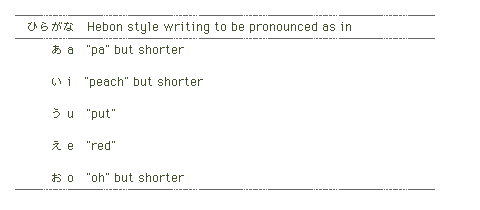
If there is a bar-line over a vowel (for example, 'o', pronounce the vowel twice the length of a single
vowel.
When two vowels are next to each other, second vowel should be pronounced as one unit sound
separated from the first vowel.
There is no silent letters in Hebon style. Hence 'mate' ( meaning "wait") is pronounced as 'mah-teh' and
NOT as an English pronunciation for 'mate' (meaning friend). The last 'e' is pronounced. 'g' and 'h' are
also pronounced as in "give" and "hat" in English respectively.
Intonation in Japanese is much less prominent than, for example, that in English. They sound almost
flat, although there are small amount of intonation that does make difference in meaning.
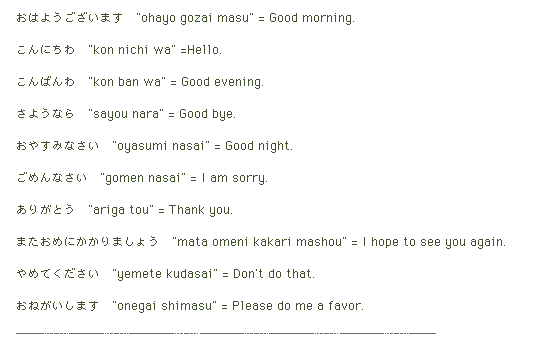
'-san' = This word is a suffix attached at the end of a name of a person, corresponding to Mr. Mrs. or
Miss (or Ms for that matter).
'-kun'= Same as above for a friend or a person under you.
In Japan, Family name is the standard to call a person, and not by a first name unless you became to be
a close friend to this person.
|

